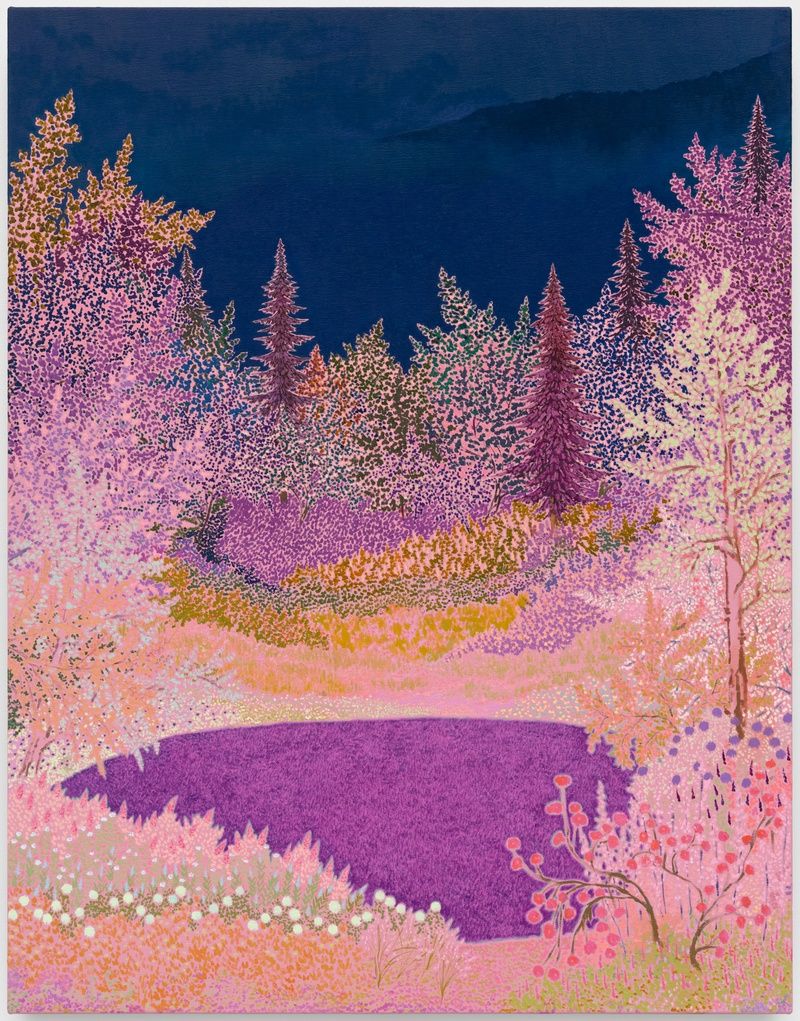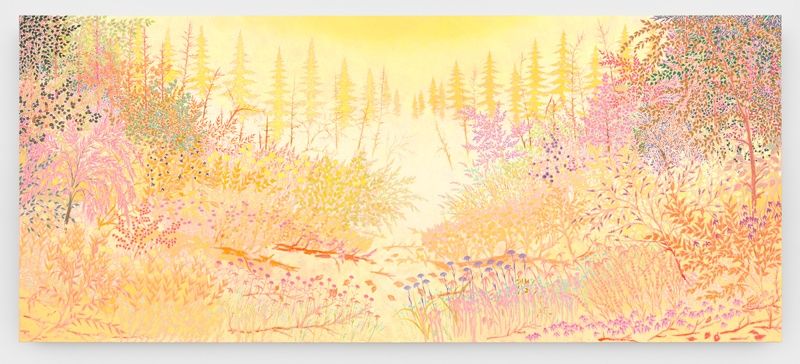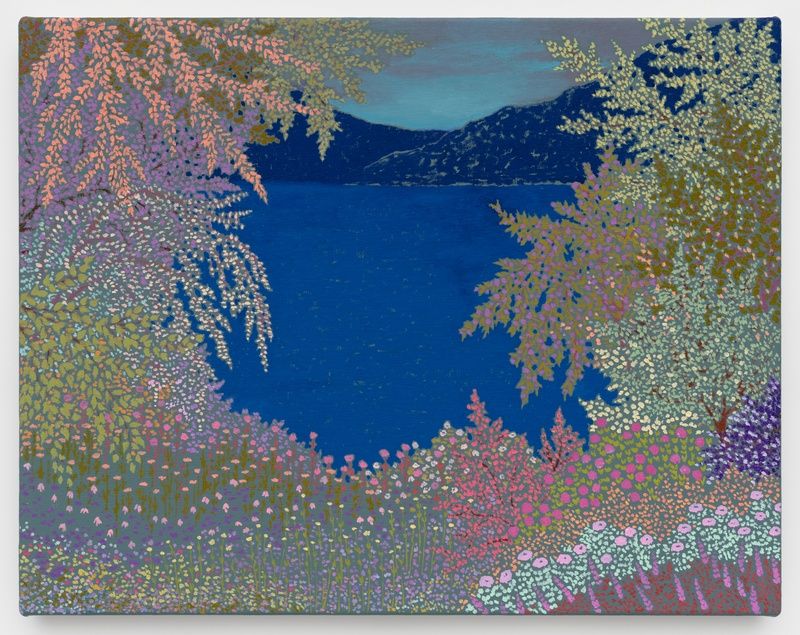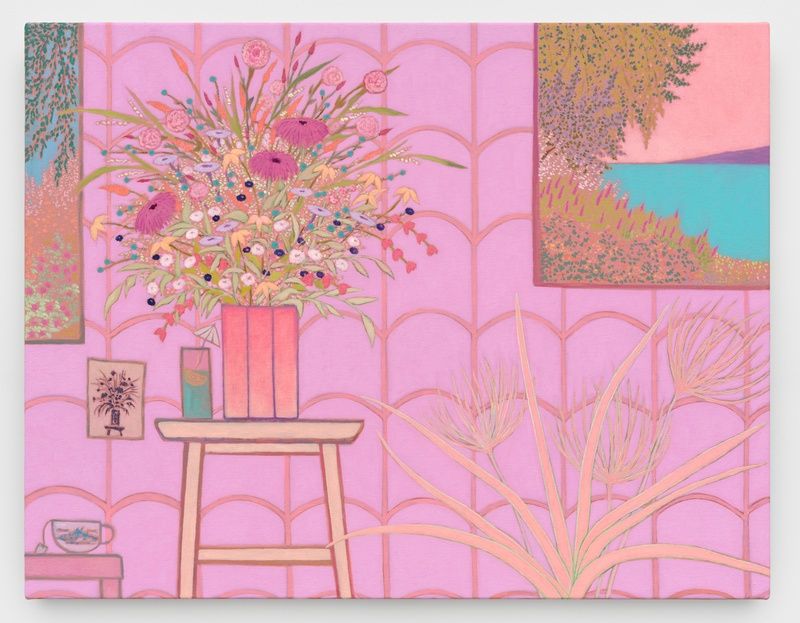James Fuentes Gallery
John McAllister
sometimes splendid seeming...stellar even...ripping
James Fuentes is delighted to present John McAllister, sometimes splendid seeming...stellar even...ripping at its Los Angeles location, a new body of landscape and still-life paintings capturing the temporal and symbolic cycles of nature. On his ritual bike rides through the land surrounding his home in Florence, Massachusetts, McAllister absorbs the winter’s short days and decaying forests, and returns to his studio to preserve the evolving land on canvas—illuminated with glistening, early sunsets and cloaked with dense, starry skies.
McAllister depicts wilderness in a ceaseless “in between,” where spring and fall disrupt the stillness of winter and thrum of summer through perpetual rot and rebirth. In turn, the artist’s practice also mirrors his personal position at the intersection of youth and old age—comprehending his mortality as it exists in relation to his child and parents. In each landscape, McAllister gently contrasts the singular course of human life with the perennial cycles of the environment; fields may decay under the trodden path of the wanderer, but the land will inevitably grow back, erasing all footsteps that came before.
McAllister depicts nature with an exaggerated palette and shifting scale that emphasize the sensational and metaphorical—brush strokes and stipples made with sublime and saturated yellows, oranges, pinks, and purples that wash through pastel sunsets. Like time, McAllister paints in a linear sequence that becomes cyclical, moving from one side of the canvas to the other as he populates a warm, monochrome background with precisely placed imprecise marks. Each view is detailed with small brushes that are disproportionate to these sometimes vast canvases, creating dense patterns of breezing leaves, petals, and branches lit by a cresting moon or vanishing sun.
In each element of his compositions, McAllister strives to behold nature as a version of reality assembled by, and filtered through, the human mind. Through these glimmering, seamless transitions between land, water, shadow, and sky, he reveals the distortions that live in our senses of time and space. How can our eyes simultaneously perceive plants that are mere inches in front of us in the same manner as stars that are light-years away? René Descartes is a recurring reference:
Like the painters who, finding themselves unable to represent equally well on a plain surface all the different faces of a solid body […] I resolved to expound singly, though at considerable length, my opinions regarding light; then to take the opportunity of adding something on the sun and the fixed stars, since light almost wholly proceeds from them; on the heavens since they transmit it; on the planets, comets, and earth, since they reflect it; and particularly on all the bodies that are upon the earth, since they are either colored, or transparent, or luminous; and finally on man, since he is the spectator of these objects.¹
McAllister’s application of light as a metaphysical symbol in nature is further complicated in his still-life paintings. In these idyllic interiors, evenly-lit, presumably climate-controlled rooms are furnished with perky flower bouquets, iced drinks, hot tea, and abandoned wrist watches. Instead of windows, from bright pink walls we look out into hung paintings where nature remains preserved in an abstracted and flourishing bounty. These serene, steady domestic scenes add an extra dimension to McAllister’s emphasis on the intensity and variability of the light that flows through his landscapes—which here become pictures within pictures
The title of his most ambitious panorama, beacon beaming tumult teaming chorus clamour, contains a playful contradiction: the imperceptibility of looming chaos when beholding an instance of natural beauty. Unlike the other paintings, this forest glows with a diffused and crackling light emerging from somewhere just beyond the horizon—as if from a blazing fire about to consume everything in sight. In McAllister’s phenomenology of nature, life in all its variable patterns are imagined equally sentimental and haunting.
John McAllister (born in 1973 in Slidell, Louisiana) lives and works in Florence, Massachusetts. He received his BFA from the University of Texas, Austin, and his MFA from Art Center College of Design, Pasadena, California. His work is included in public collections at the Hammer Museum, Los Angeles, Rubell Family Collection, Miami, and Consortium Museum, Dijon, France. Recent solo exhibitions include sometimes symphony clatter calm, 2023, Wentrup Gallery, Berlin, Germany; be delirious reveries ringing, 2022, Almine Rech, Brussels; 2020; adrift gleaming serenest rustling air, 2020, Wentrup Gallery, Berlin, Germany; and silence sounding sumptuous, 2019, James Fuentes, New York. McAllister will have a solo exhibition at MASSIMODICARLO at their Hong Kong location in November 2024.
¹ René Descartes, Discourse on the Method of Rightly Conducting One's Reason and of Seeking Truth in the Sciences, originally published 1637, France.

John McAllister
darksome night bright beaming, 2024
Oil on canvas
50 × 39 inches
Works

beacon beaming tumult teaming chorus clamour, 2024
Signed and dated verso
Oil on canvas
72 × 168 inches

revel late merry make, 2024
Oil on canvas
27 × 35 inches

depths divined deepening, 2024
Signed and dated verso
Oil on canvas
18 × 23 inches

dawning late luxuriate, 2024
Oil on canvas
27 × 35 inches